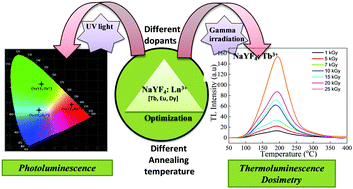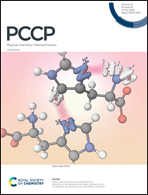Investigation of thermoluminescence and photoluminescence properties of Tb3+, Eu3+, and Dy3+ doped NaYF4 phosphors for dosimetric applications
Abstract
Hexagonal phase sodium yttrium fluoride activated with lanthanide ions; Tb3+, Eu3+ and Dy3+ doped NaYF4 phosphors were synthesized using a simplistic hydrothermal method. The photoluminescence studies demonstrated green, red and blue emission lines corresponding to 5D4 → 7FJ (J = 6, 5, 4, 3), 5D0 → 7FJ (J = 1, 2 and 4) and 4F9/2 to 6HJ (J = 15/2 and 13/2) transitions, which are characteristic of Tb3+, Eu3+ and Dy3+ ions, respectively. The as-synthesized samples were subjected to annealing at varying temperatures from 500 °C to 800 °C primarily for the optimization of the thermoluminescence glow curve. Meanwhile, we studied the influence of thermal annealing treatment on the crystal phase, morphological features, and photoluminescence properties of the phosphors. The spherical-like morphology of NaYF4:Tb3+ phosphor changed to micro block-like structures and the hexagonal phase of NaYF4 transforms into a cubic phase at a higher annealing temperature of ∼800 °C. The photoluminescence emission intensity also varied at different annealing temperatures. The systematic study using different dopants and annealing temperatures was carried out to accomplish efficient thermoluminescence (TL) properties. The most suitable TL dosimetric glow peak was attained for NaYF4:0.5%Tb3+ phosphor, which was annealed at a temperature of 800 °C, located at 194 °C. The NaYF4:Tb3+ phosphor exhibited TL response fairly linear in the dose range from 1 kGy to 25 kGy of gamma radiation. The phosphor showed TL response at higher doses, which stipulates that the NaYF4:Tb3+ is reasonably well suitable for high dose measurements and respective applications. The phosphor exhibited negligible fading and good reproducibility features. Trap-level analysis and experimental determination of activation energy were performed using the Tm–Tstop technique and initial rise method (IRM). The trapping parameters of the TL glow curve, such as activation energy (E), order of kinetics (b), and frequency factor (s) were estimated by Chen's glow peak shape (PS) method and glow curve deconvolution (GCD) method. The trapping parameters obtained using the IRM, PS and GCD methods are in good accordance with each other. Henceforth, along with efficient photoluminescence properties, the NaYF4:Tb3+ phosphor exhibited favorable thermoluminescence dosimetric properties. Consequently, this study provides new opportunities for utilizing these phosphors in the area of radiation dosimetry applications such as environmental and food monitoring, space dosimetry etc.



 Please wait while we load your content...
Please wait while we load your content...